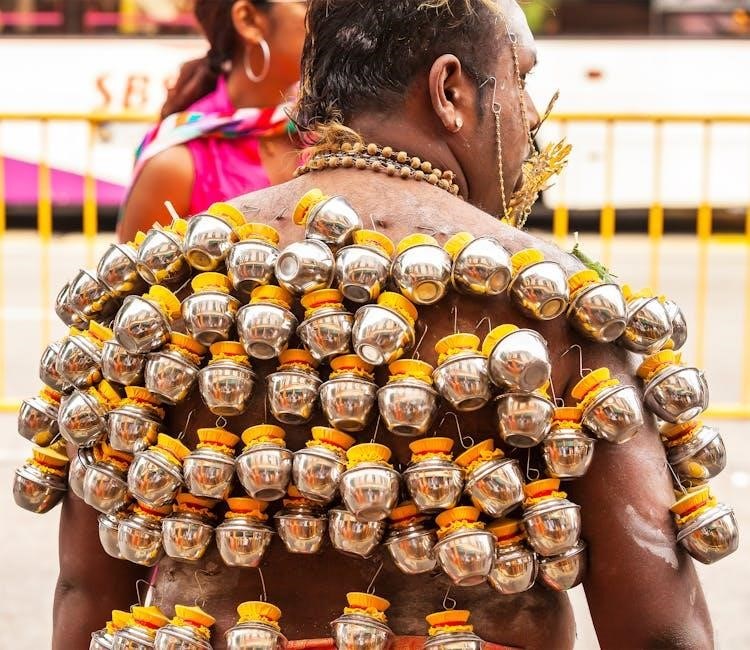Horace Miner’s 1956 essay satirically explores the Nacirema culture, revealing their obsession with body rituals, shrines, and magical practices, offering a unique critique of American societal norms.
Overview of the Nacirema Culture
The Nacirema culture is deeply rooted in ritualistic practices centered around the human body. Their society is characterized by a relentless pursuit of economic success and a fascination with bodily appearance. The Nacirema believe the body is inherently flawed, driving their obsession with rituals to maintain health and youth. These practices often involve magical potions and charms, reflecting a blend of superstition and cultural values. Households typically contain shrines dedicated to these rituals, and there is a widespread belief that parents, especially mothers, may bewitch their children during the teaching of these customs. This unique cultural framework highlights their complex relationship with the human form.
Horace Miner and His Ethnographic Study
Horace Miner, an anthropologist, conducted a groundbreaking ethnographic study titled “Body Ritual Among the Nacirema,” published in 1956. His work presented a satirical analysis of American cultural practices by describing them through the lens of an outside observer. Miner’s essay humorously highlighted the peculiarities of daily rituals, such as the use of magical potions and the presence of household shrines. His approach challenged conventional perceptions and encouraged a critical examination of societal norms. The study remains a significant contribution to anthropology, illustrating the power of cultural critique through ethnographic storytelling.

The Cultural Significance of Body Rituals
The Nacirema’s body rituals reflect deep cultural values, emphasizing health, appearance, and youth. These practices, often performed in household shrines, highlight societal obsessions and beliefs.
The Nacirema’s Obsession with Bodily Appearance
The Nacirema’s fixation on bodily appearance is central to their culture. They believe the body is inherently flawed, necessitating constant rituals to improve and maintain it. Each household contains shrines where daily ceremonies are performed to enhance beauty and health. These practices, often involving magical potions and charms, reflect a societal belief that external appearance is a reflection of inner worth. This obsession drives their economic pursuits, with a vast industry dedicated to beauty and wellness products. Their rituals not only maintain physical health but also serve as a means to attain social status and acceptance.
The Role of Shrines in Nacirema Households
In Nacirema households, shrines are central to their ritual practices. These sacred spaces are dedicated to ceremonies aimed at enhancing bodily health and appearance. Each shrine typically contains magical items and potions used in daily rituals. Family members perform these ceremonies to ward off perceived bodily imperfections and to attain spiritual purity. The shrine serves as a focal point for both individual and communal rituals, reinforcing the cultural belief in the power of magical interventions. This religious-like devotion underscores the Nacirema’s deep-seated belief in the transformative power of ritual practices.

Daily Rituals and Practices
The Nacirema engage in elaborate daily rituals, including morning and evening ceremonies involving magical potions and charms. These practices are deeply rooted in their cultural beliefs.
Morning and Evening Rituals
The Nacirema perform intricate rituals twice daily, centered around bodily care. In the morning, they cleanse themselves with water and apply potions to enhance appearance. Evening rituals involve similar practices, often conducted in private shrines. These ceremonies are believed to prevent decay and maintain health. Mothers teach these customs to children, emphasizing their importance. The use of magical charms and powders is common, reflecting a deep cultural commitment to bodily perfection. These daily practices highlight the Nacirema’s obsession with their physical form and their reliance on ritual to achieve desired outcomes.
The Use of Magical Potions and Charms
The Nacirema employ a variety of magical potions and charms to enhance their bodily appearance and health. These potions, often purchased from medicine men, are believed to possess supernatural powers to prevent aging and decay. Sacred powders and liquids are applied during rituals, with specific chants and ceremonies to invoke their effectiveness. Mothers play a crucial role in teaching these practices, emphasizing their importance for maintaining youth and beauty. The reliance on these magical substances underscores the Nacirema’s deep belief in their ability to influence bodily outcomes through ritualistic means.

Magic and Medicine in Nacirema Society
Magic and medicine are deeply intertwined in Nacirema culture, with rituals and potions believed to prevent decay and enhance bodily health, reflecting their obsession with appearance and youth.
The Influence of Medicine Men
In Nacirema society, medicine men hold significant influence, prescribing magical potions and charms to address bodily concerns. Their rituals are believed to cure ailments and enhance appearance, reinforcing cultural beliefs in the power of medicine to combat decay and aging. These practitioners are viewed as authorities, blending spiritual and physical remedies to maintain health and youth. Their practices, often performed in household shrines, highlight the intersection of magic and medicine in Nacirema culture, showcasing the deep-rooted faith in ritualistic solutions to bodily imperfections and the quest for eternal vitality.

Rituals to Prevent Aging and Decay
The Nacirema believe the human body is inherently vulnerable to decay, necessitating constant ritualistic intervention. They employ a variety of practices, including magical potions and charms, to counteract aging and maintain physical vitality. Daily rituals, often performed in household shrines, involve intricate ceremonies to ward off decay and enhance beauty. These practices reflect a deep cultural anxiety about aging, driving the Nacirema to seek perpetual youth through both magical and medical means. Their rituals highlight the profound interconnection between health, appearance, and spiritual beliefs in their society.
Family and Ritual Practices
Family rituals are deeply rooted, with mothers teaching sacred practices, often under suspicion of casting curses on their children, highlighting cultural beliefs in bewitchment.
The Role of Mothers in Teaching Rituals
Mothers play a central role in instructing children in sacred rituals, often conducted in secrecy; Despite their importance, mothers are frequently accused of casting curses on their offspring. This belief underscores the cultural tension between nurturing and suspicion, as mothers are both educators of vital practices and perceived sources of potential harm. The transmission of rituals from mother to child reinforces cultural continuity, even as it perpetuates fears of bewitchment. This duality highlights the complex interplay between family bonds and societal superstitions in Nacirema culture.
Beliefs About Curses and Bewitchment

The Nacirema believe that curses and bewitchment are common threats, often caused by close relatives. Mothers, in particular, are suspected of casting curses on their children while teaching them secret rituals. This belief reflects a deep-seated fear of supernatural harm within familial relationships. Rituals are performed to counteract these curses, emphasizing the importance of protective magic in daily life. The fear of bewitchment underscores the societal tension between trust and suspicion, even among kin. These beliefs highlight the intricate interplay between spiritual concerns and interpersonal dynamics in Nacirema culture.
The Satirical Element in Miner’s Essay
Horace Miner’s essay humorously critiques American culture by presenting everyday rituals as peculiar, highlighting societal obsessions with appearance and health through a satirical, ethnographic lens.
Critique of American Cultural Practices
Horace Miner’s essay critiques American cultural practices by portraying them as exotic rituals. He highlights the Nacirema’s obsession with bodily appearance, health, and youth, revealing societal pressures. The essay satirizes the reliance on consumer products and medical practices, framing them as magical rituals; Miner’s critique underscores the commercialization of beauty and wellness, showcasing how cultural norms drive these behaviors. By presenting familiar practices as strange, Miner challenges readers to reflect on the absurdity of societal expectations, offering a sharp commentary on American values and consumer culture.
The Relevance of the Essay in Modern Anthropology
Horace Miner’s essay remains a cornerstone in anthropology, offering timeless insights into cultural relativism. Its satirical approach continues to resonate, as it challenges readers to reflect on their own cultural practices. The essay is widely used in academic settings to illustrate how seemingly ordinary rituals can appear strange when viewed through an outsider’s lens. This perspective encourages critical thinking about ethnocentrism and the importance of understanding cultural contexts. By highlighting the Nacirema’s obsession with bodily rituals, Miner’s work underscores the enduring relevance of anthropological analysis in understanding human behavior and societal norms.
Accessing the Full PDF Version
The full PDF of “Body Ritual Among the Nacirema” is available on JSTOR, academic databases, and various online platforms for free or institutional access.
Online Sources for the PDF
Academic References and Citations
Horace Miner’s essay, “Body Ritual Among the Nacirema,” is widely cited in academic literature. The original article was published in the American Anthropologist in 1956 (Vol. 58, No. 3, pp. 503-507). Scholars such as Barbara Kirsheblatt-Gimblett have referenced this work in discussions of cultural satire and ritual practices. Proper citation format includes Miner’s name, publication year, article title, journal name, volume, issue, and page numbers. Academic databases like JSTOR provide access to the original text, ensuring its availability for research and citation in modern anthropology studies.
Miner’s satirical essay critiques American culture through Nacirema rituals, highlighting societal obsessions and offering enduring anthropological insights into human behavior and cultural practices.
Horace Miner’s essay, Body Ritual Among the Nacirema, satirically examines the cultural practices of a fictional tribe, revealing their obsession with bodily rituals, shrines, and magical potions. The Nacirema’s fixation on appearance and health reflects broader societal values, critiquing American culture’s emphasis on materialism and superficiality. Miner’s study highlights the importance of understanding cultural contexts and the potential for satire in anthropological analysis. The essay remains a significant work in anthropology, offering insights into human behavior and the extremes of ritualistic practices. Its relevance endures, providing a critical lens for modern societal norms.
The Enduring Importance of the Study
Horace Miner’s Body Ritual Among the Nacirema remains a seminal work in anthropology, offering timeless insights into cultural practices and societal values. Its satirical critique of American norms continues to resonate, making it a cornerstone in academic discussions. The study’s ability to blend humor with critical analysis has ensured its relevance across generations. It underscores the importance of understanding ritualistic behaviors and their significance in shaping cultural identities. As a widely studied and accessible text, the essay’s influence persists, providing a foundation for exploring the intersection of culture, ritual, and human behavior in modern anthropological studies.
